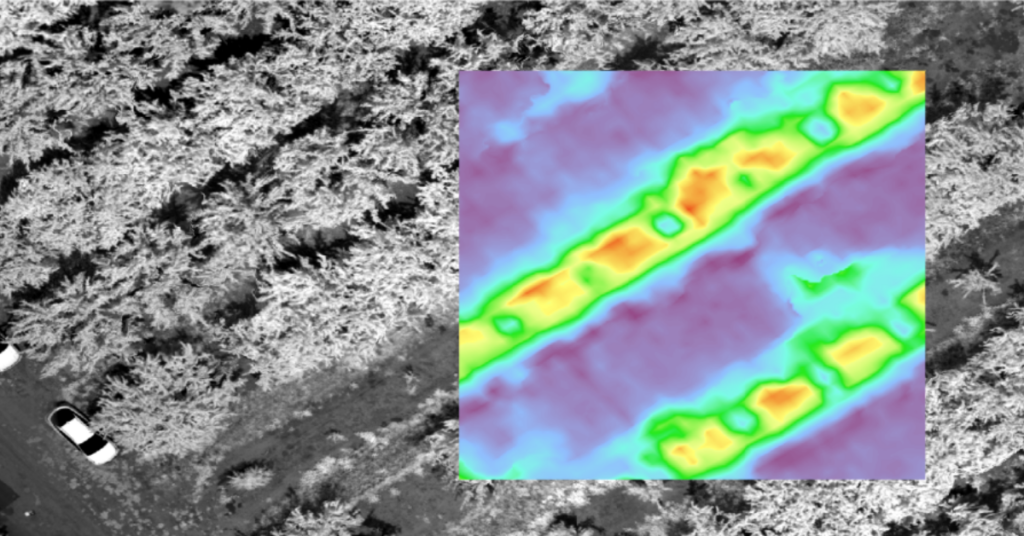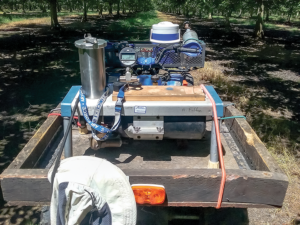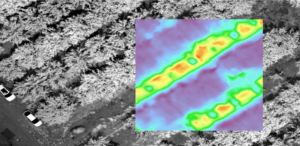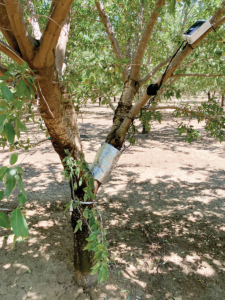
November/December 2023
Irrigation Tech: A look at what’s new for nut growers
The nut industry is moving quickly into a new era of irrigation technology, where remote sensing through drone and eventually satellite data can inform growers about the real-time stress status of orchards.
“That’s obviously the ‘holy grail’ of irrigation tech in the mind of many researchers and will absolutely revolutionize irrigation management as it becomes more accessible,” said Curt Pierce, Ph.D., area irrigation and water resources advisor for the University of California Cooperative Extension. “These tools have been in development for some time and have seen some impressive jumps in utility as the technology matures.”

Of course, some challenges on the remote sensing side remain, with cost and resolution being the two most pressing issues.
“Drones are becoming more affordable, but remain comparable to other, more mature tech such as pressure chamber devices, which haven’t experienced the adoption rates we would expect considering their potential benefits when used effectively,” Pierce said. “Resolution remains a bit too coarse on the satellite side to be as useful as we would like for meaningful use in production. These are naturally temporary challenges inherent in tech that will likely ease in tandem as the technology continues to evolve.”
On The Ground
Away from the air, the industry has seen some encouraging developments in microtensiometers, which are plant-based devices that are installed and remain in a plant for the season, delivering real-time water status data to an app that growers can see on their phones.
“They are small, fairly durable, and have good agreement with the pressure chamber, which I believe, remains the gold-standard in plant water status measurement, but have struggled towards widespread adoption across the industry,” Pierce said. “These new microtensiometers address the main challenge frequently cited by growers with the pressure chamber, and that is labor.”

Thanks to new in-situ sensors, it’s mostly a once- and-done install for the season, with the data revealed through the app with only periodic re-calibration needed in the majority of cases.
“The challenge there is that these new microtensiometer units are still relatively expensive as far as the initial investment, though I believe some subscriptionmodels may be being offered by companies to help ease entry a bit,” Pierce said. “Overall, though, these remain a very exciting innovation that could really fill a gap between the pressure chamber and remote sensing.”
Tom Devol, senior manager of field outreach and education for the Almond Board of California, noted that there is a new area of irrigation tools that are plant- based, taking the measurements off the tree itself, rather than measuring the volume of moisture in the soil.
Those include dendrometers, which measure the growth of a tree branch or stem, where some newer systems are inserted into the tree and measuring fluid flow.
“Those are making a larger footprint in the space,” Devol said. “What growers like about this is it replicates a stem-water potential measurement that they might use with a pressure chamber.”
Devol also is seeing more tensiometers being employed to measure soil moisture — especially in the Southeast, though he warns that for nut tree crops, they don’t always read a large enough range, but improvements have been coming.
Because of California’s Sustainable Groundwater Management Act (SGMA), the majority of U.S. pistachio growers will be forced to implement new irrigation technologies if they haven’t already done so, said Wes Wilson, director, member services and communications for the American Pistachio Growers.
Particularly for pistachios and almonds, dendrometers are a tool that has been making a major impact as growers are looking for something to meet the SGMA requirements, he said.
“Big technology in irrigation has advanced dramatically and it’s continuing to,” Wilson said.
He noted that having a remote-operated station delivering live weather data is highly popular among nut growers. Soil-moisture probes are also being utilized more.
“We’re starting to see a lot of remotely controlled irrigation pumps,” he said. “If I was a grower, I could completely control my irrigation and my fertigation, and my pumping from my phone.”
Another tool making inlays into improving irrigation for tree nut growers is remote imaging, with data being applied to help drive an irrigation schedule.
“A number of vendors are using satellite imagery to estimate water consumption and then they give the grower a value they need to replace,” Devol said. “This is pretty cutting edge, and it’s still not perfect yet, but there has been a lot of movement in this direction because it removes the need to install and maintain sensors out in the field, which for a lot of growers, is a huge benefit.”
Measuring cosmic rays to determine soil moisture using a neutron detector is being leveraged in research today, and this is intended to measure large areas of soil, as much as a 100-acre footprint.
A Proper Irrigation Program
From talking to his clients and doing events in California, Pierce has learned the best way to approach technology in an irrigation program is to first understand the soil.

“So much of what makes a good irrigation program is based on the soil and how it fluctuates throughout an orchard,” he said. “It’s an unfortunate reality that many irrigation systems are designed without really taking that into account, which limits the ways in which different technologies can be utilized after the fact.”
For that reason, Pierce recommends growers should take a “good, better, best” approach to any assessment, or re-assessment, of their systems.
“Soil moisture monitoring through different sensor technology has been around for a long time and only gets better with each passing year and the new technological developments that come with them in that space,” he said. “But soil moisture alone can only tell you so much and misses any accounting of the tree’s ability to effectively access whatever water is stored in the soil. It’s good to have that information, and it certainly can go a long way in informing any irrigation program.”
Devol feels it’s a bright future for irrigation tech, and growers should stay informed about the latest and greatest from conventions and network of farm advisors.







